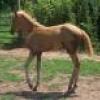Catch a Bird chimeric?
Forums
Re: Catch a Bird chimeric?
I would bet that he wasn't tested. If he had, his owner would have mentioned it in this thread:
[url]http://www.pedigreequery.com/node/]
She last posted there in late February 2007, and as of late April 2007 he had passed away.
Although the way I interpret his color, I wouldn't expect him to test as chimeric. What I imagine happened with him is that somewhere in his early development a mutation occurred (causing a roan coat color pattern), and that cell's daughter cells caused his striping and roan offspring.
eta - ditto on his previous owner being a nutjob and I don't think she would have tested him either. This article has quotes from her that describe what she was trying to do:
[url]http://www.geelongadvertiser.com.au/art…]
From what she said I don't think she would have had the idea to test for that in particular. Besides, if she couldn't (presumably) afford to feed her horses, would she really be forking out the cash to test him?
Re: Catch a Bird chimeric?
[quote="nerd"]if she couldn't (presumably) afford to feed her horses, would she really be forking out the cash to test him?[/quote]
Quite possibly yes. I know of a person who's horses were ridiculously under weight, but she was spending money just about willy nilly on anything she pleased.
Re: Catch a Bird chimeric?
You know, it's been awhile since I first read this and such, but going back through the old links I noticed that one of Catch A Bird's ancestors looked a lot like him (even in black and white)...it was Wawmaw or something like that and it was pretty far back (early 1900s?).
I also find it facinating that a fair number of the "unique" TBs whose colors/patterns we've discussed on this site (and preceeding site), are in his pedigree...Bird Catcher and The Techrarch, just to name a few.
Re: Catch a Bird chimeric?
[quote]Although the way I interpret his color, I wouldn't expect him to test as chimeric. What I imagine happened with him is that somewhere in his early development a mutation occurred (causing a roan coat color pattern), and that cell's daughter cells caused his striping and roan offspring.[/quote]
I completely agree. It was something environmental that caused the white striping, but mutation that caused the roan. Heck, the environmental conditions could have had a hand in causing the mutation.
White striped brindles are phenotypically distinct from chimeras or genetic brindles. I personally believe that they are caused by environmental conditions that inhibit full melanocyte migration from the neural crest. :geek:
It would explain why some white marked brindles only have the white on one side, and why they don't pass on their crisp white markings to offspring, or test positive as chimeras.
Re: Catch a Bird chimeric?
[quote="Threnody"]White striped brindles are phenotypically distinct from chimeras or genetic brindles. I personally believe that they are caused by environmental conditions that inhibit full melanocyte migration from the neural crest. :geek:
It would explain why some white marked brindles only have the white on one side, and why they don't pass on their crisp white markings to offspring, or test positive as chimeras.[/quote]
This is not exactly how I see it--I think it's not a matter of inhibiting melanocyte migration, but rather a mutation that happens to occur just before melanocyte migration occurs. This means the horse would be a genetic mosaic, not a chimera. Such a mutation would either (a) have no effect on melanocyte function, in which case we wouldn't notice, or (b) have an effect on melanocyte function, in which case you would see the 'trail' of mutated daughter melanocytes manifested as a differently colored stripe. The reason I think these are more often white stripes is that it's much easier to break color expression (ie, mutate the melanocyte in some way that causes it to cease producing melanin altogether) than to change it in a mild way that modulates it (producing an intermediate color). In other words I think the white stripes contain melanocytes that aren't functioning normally, rather than being areas where melanocytes have failed to migrate to.
I think this is how it supposedly works in humans--you might find the following articles interesting:
[url=http://archderm.ama-assn.org/cgi/reprin… R. [i]Mosaicism in human skin[/i] Arch Dermatol 1993; 129: 1460–1470[/url] (talks about mosaicism in humans and the similar skin patterns that result)
[url=http://jmg.bmj.com/content/30/9/752.ful… C et al. [i]Epidermal mosaicism and Blaschko's lines[/i] J Med Genet 1993; 30: 752-755[/url] (shows that stripes are due to genetically different cells, and argues why this is often missed when the wrong cell type is tested)
Re: Catch a Bird chimeric?
That makes sense and stands as a very good possibility. Now I want Natal tested for this ^_^
The origin of the affected cells radiating from the neural crest is something I've noticed from how they were distributed on the body.
However, I am curious as to those individuals whose white brindle appears to create markings that are trailing from these lines, such as the Arab mare and the one brindle blanket appy filly in the Appaloosa Project folder for brindle. It is completely possible that this may be the cause of their appearance as well.
Unfortunately I cannot find the article I originally read this from, but I remember it stating that white markings in domesticated animals developed at a later time than the main pigmented body color. Statement from an unknown source I know. I'm wondering if anyone has read or known of any articles that may touch on this subject?
Re: Catch a Bird chimeric?
The main reason why I am wondering is because Dunbar's Gold's white markings appear normal, in comparison to the rest of his body color. Because of the article I once read I always viewed this as making sense since I would assume that white markings form after the two embryos have fused.
Re: Catch a Bird chimeric?
Sorry Acc, I don't know what you're specifically asking. I would guess the markings and white patterns are determined early on by the genetic makeup, but stand a chance of having mutation occur at any time, i.e. in the gamete before embryo formation, or while developing later creating a patch of somatic mutation. Not really sure of what you mean though. Maybe what determines when they are formed?
I personally (again, personally) don't see chimeras as being able to fuse [u]after[/u] white markings have formed. The cellular phases in which two embryos can fuse, and cause brindle stripes or chimeric patches, seems rather small. I assume its within approximately 16 days after fertilization before the embryos anchor to the uterine wall. So I would make an educated guess that white pattern formation occurs after the first 16 days. Lots of time, but I personally have no true idea of exactly when white patterns would form.
I would think a chimera has a good chance of expressing whatever patterns both sets of DNA are capable of, if both sets have some form of influence over the neural crest. If one has roan and the other has tobiano the individual could theoretically express both if white patterns occur after embryo fusion. Though chimerism in horses is rare enough that it would likely be hard to determine. Unless a chimera is born with two sets of DNA that each have a seperate testable pattern that the other set does not also share. Or someone starts making them in a laboratory. The weird thing is with today's technology, it's probably possible. :shock: I'm imagining "franken-ponies" right now...
Re: Catch a Bird chimeric?
I checked out that pedigree site. o_O Are horses like him supposed to loose their pattern with age?
Why would you think he was chimiric? Aside from pattern is I guess. But that never crossed my mind with him, because I thought you had to be blood typed any way to register with the JC? And if he was chimiric, wouldn't it have been the same story as with the brindle AQHA horse a few years ago?
Re: Catch a Bird chimeric?
[quote="JNFerrigno"]I checked out that pedigree site. o_O Are horses like him supposed to loose their pattern with age?
Why would you think he was chimiric? Aside from pattern is I guess. But that never crossed my mind with him, because I thought you had to be blood typed any way to register with the JC? And if he was chimiric, wouldn't it have been the same story as with the brindle AQHA horse a few years ago?[/quote]
Yes they have to be DNAd. However, as long as they don't get hair from two individuals (or even if the lab gets both hairs but only uses one (one that makes sense) it could easily be missed.





Re: Catch a Bird chimeric?
Bwahaha! I have planted a seed in your mind. ^_^
The veterinarian, Julie Tilbrook (of all people to neglect horses) was uneducated about the whole concept of brindle coloration. She thought that if she used Catch A Bird's offspring that she may be able to reproduce the color. She did no testing on the foals she obtained for her breeding "experiment".
http://bridlepath.wordpress.com/categor…" onclick="window.open(this.href);return false;
The pick of Slip Catch as skin and bones is sad since I've seen his baby pics...